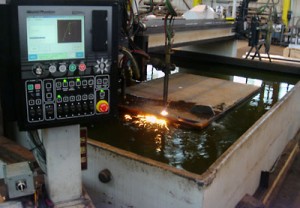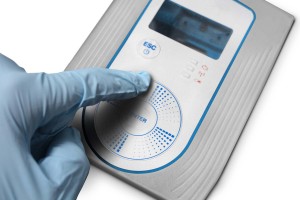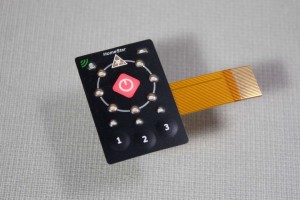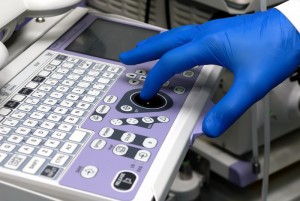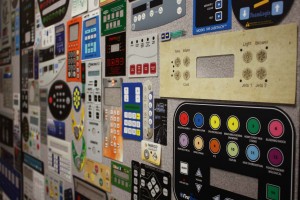Membrane switch designers and manufacturers are faced with ever-advancing technology and increasing demands to meet both aesthetic and functional requirements. As electronic devices become more advanced and smaller in size, designers must blend creativity with expertise to provide solutions for a growing variety of applications. Here’s a look at some recent and emerging trends for membrane switch manufacturers.
1. Producing Membrane Switch Assemblies for Harsh Environments
Gone are the days of electronics that can’t be used in the rain or near water. Today’s devices are not only expected to offer some level of resistance to common hazards, such as rain, but many devices are designed specifically for use in harsh environments, such as manufacturing or chemical processing applications.
These use cases demand a higher level of durability. Membrane switch designers are adapting to this trend through the use of more durable components and processes, such as special pressure-sensitive adhesives that won’t break down following exposure to solvents or other liquids, choosing silicone rubber keypads to add protection for underlying circuit layers, or the use of a special adhesive sealing process for added durability.
2. Integrating Component Manufacture and Assembly
A membrane switch assembly is more than the mere sum of its parts, yet its functionality and reliability depend heavily on the quality of the individual components. The failure of one component, such as the adhesive layer, can lead to further deterioration of or damage to circuit layers and other components, resulting in device failure.
For this reason, more membrane switch manufacturers are opting to integrate component manufacture and assembly under the same umbrella, providing the ultimate in quality control. This also eliminates compatibility challenges and minimizes the number of vendors with which a company must contract and sub-contract for the desired result.
3. Membrane Switch Requirements Become Increasingly Complex
Product manufacturers are coming up with innovative ideas, but membrane switch manufacturers are tasked with configuring the right solutions to enable the functionality envisioned by product designers. Finding the right balance between functional requirements and consumer demands related to usability and aesthetics is rarely an easy task, but it’s one accomplished in impressive ways by leading membrane switch manufacturers.
Membrane switches are now capable of offering continuous action for scrolling and slide bars with a low actuation force, technology that mimics capacitive touch interfaces. Others offer built-in antimicrobial protection for healthcare applications. And other membrane switch designs are integrating multiple sub-assemblies for complex configurations and a range of control options for a single device. As product requirements become more advanced, membrane switch manufacturers readily adapt to trends and develop functional solutions to the most challenging product requirements.
4. Maintaining Usability in Increasingly Smaller Space Constraints
The overall trend towards micro-electronics poses a unique challenge for membrane switch manufacturers. These devices still require operation, yet integrating the functional controls needed to operate a device in a space that’s merely a fraction of the size of the typical user interface is no simple undertaking. A loss of usability is always a risk when adding more functionality to a smaller interface.
But, with advancements like smaller printed circuit boards and other components that can provide the level of functionality required by sophisticated devices without the massive components required in previous years, these results are attainable. The most experienced membrane switch designers are able to configure the required functionality using a precise combination of components and options to maintain usability without sacrificing function or aesthetics.
5. Minimized Carbon Footprints
Many of the components and materials used in early electronics design lead to a large carbon footprint for product manufacturers. By using alternative component options, membrane switch manufacturers are able to mimic the same robust look and feel without the same environmental impact or high production costs associated with materials such as stainless steel.
Additionally, the introduction of more environmentally friendly printing options, such as digital printing, allow environmentally conscious companies to reduce their carbon footprint, passing these advantages along to end consumers.
6. Longer-Life Components
In some applications, device failure is much more than an inconvenience. In the healthcare industry, failure of a medical device can be life-threatening. The increase in use of medical devices and equipment by patients in their homes has led to a demand for components with extended lifespans and less risk of failure.
Medical devices must also be resistant to exposure to hazardous materials, such as cleaning products, to avoid premature device failure. Even components such as backlighting have evolved, and there are now several low-power options with longer anticipated lifespans or the ability to easily replace lighting components without disassembling the entire membrane switch assembly.
7. Expanding Markets and Regions
While the membrane switch industry must remain agile and adapt to emerging trends, the outlook remains optimistic for membrane switch manufacturers. As more global regions begin to see an increase in consumer electronics usage, such as washing machines and air conditioners in India, the demand for membrane switch assemblies will continue to grow.
Beyond global expansion, the use of membrane switches will continue to saturate both consumer and industrial markets. Membrane switches are used for a wide range of products and devices, ranging from entertainment devices to home appliances, medical equipment, such as ultrasound equipment, security systems, and an endless array of commercial devices and applications.
Membrane switches are used in many of the devices most people use in everyday life. As the technology average consumers rely on for day-to-day use becomes more advanced, membrane switch manufacturers continue to work toward more innovative, functional, and aesthetically pleasing components and assemblies that provide the ideal blend of function, visual appeal, and usability. And as more durable and lasting components and materials are introduced, membrane switch manufacturers evaluate the latest developments to identify the best combination of components to extend the lifespan of the devices consumers rely on for communication, entertainment, and other daily activities.
Product manufacturers who partner with leading membrane switch manufacturers have access to the most innovative and experienced designers who can come up with workable solutions for even the most challenging applications. Those who partner with forward-thinking membrane switch designers who are able to stay ahead of the latest trends have a distinct advantage over the competition.
Looking for membrane switch product samples or would you like to set up a free design consultation? You can call us directly by phone (216) 475-6704 or email Customer_Service@Pannam.com
Free Membrane Switch Design Guide
Discuss Your Interface Project
Free Engineer's Product Design Kit
ISO 9001:2015 Certified
Pannam Imaging has earned ISO 9001:2015 certification from Perry Johnson Registrars. ISO 9000 is a series of quality management systems standards created by the International Organization for Standardization (ISO), a federation of 162 member countries based in Geneva, Switzerland. The American National Standards Institute (ANSI) is the member body representing the United States.
Contact Us Today
Location :
18531 South Miles Rd.
Cleveland OH 44128, USA
Contact Us :
- +1 800-524-4123
- +1 216-475-6704
- info@pannam.com
